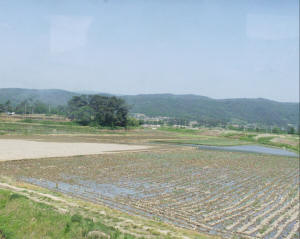 The Nak-tong
River area.
(Group leader Seiichi Nakai)
The Nak-tong
River area.
(Group leader Seiichi Nakai)
Neolithisation: 3000 BC-2nd c; Modernisation 17th c- early 20th c
Area: Areas along the Nak-tong River up to Pusan
Reasons for selection:
(1) Nkt. area is located on the narrow strait connecting the Japan Sea and the East China Sea, being also the closest region on the mainland to Japan;
(2) Intricate land forms with small plains surrounded by mountain range and the sea coast lined with numerous small islands;
(3) The Nak-tong River connecting coast with inland;
(4) Situated on a borderline between broad-leaved and ever-green broad-leaved forests, providing for a rich natural environment;
(5) Most populated area on the Korean Peninsula (large number of archaeological sites); (6) Central point in the trade network between China and Japan;
(6) Rich in valuable natural resources like steel.
Important issues during the Neolithisation period:
(1) Early adoption of agriculture from Yanzi Jiang/ Qiantang Jiang rivers areas but relatively late state formation compared to Japan.
(2) Intense trade activity with Japan and China.
(3) Numerous emigrants to Japan, the influence of Japanese old power structures.
(4) Doorway through which land cultivation, livestock farming and metalware production were first introduced into Japan.
(5) Main port area for the export of metallic materials to Japan.
Important issues during the Modernisation period:
(1) Central point in trading activities between China and Japan
(2) Reliance on inland sustenance activities and underdevelopment of fishing.
(3) Main target area for Japanese pirate attacks and Japanese invasion.
(4) Very late urbanisation. Industrial development and the introduction of monetary economy only in the 19th c.
(5) One of the Modernisation centres on the Korean Peninsula.